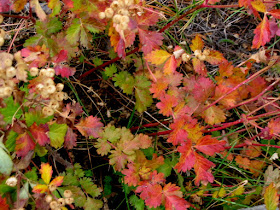Posted by Mary Small, CSU Extension in Jefferson County
 |
| Dropped branches |
A few blog articles ago, I wrote that many cottonwoods were
shedding leaves early. This was due in part to foliar diseases resulting from a
wet spring. Now, it seems, they are shedding small branches and causing a second round
of worry from their owners. (Is it winter yet?!)
This phenomenon is known as “cladoptosis”, one of those
“osis” words that strikes fear into the hearts of many. Fortunately, cladoptosis is a naturally
occurring twig drop common to many tree species, including cottonwood. And,
wouldn’t you know, it happens in the fall alongside leaf drop.
 |
| "Ball" of dropped branches |
Take a look at the bottom of the fallen, pencil sized branches underneath the tree. You’ll see nice, clean cut with a rounded, raised center. If
you tried to reattach the dropped branch to where it was originally connected, you’ll
see the two pieces make up a ball and socket arrangement. This is a big clue
that the tree was an active player and the branch drop wasn’t caused by
squirrels chewing or storm breakage or something else.
 |
| "Socket" on tree branch |
Before the branch fell from the tree, specialized cells
created a separation layer where a break occurs. The cells also created a protective layer covering the opening
in the branch remaining on the tree. This helps protect against moisture loss.
Researchers are unclear why cladoptosis occurs.
It's thought to be stress related. Affected trees may be suffering from problems
such as soil compaction issues or drought. The tree is stressed, so it “cuts its losses”
by shedding less vigorous plant material, enabling it to better support more
vigorous portions. Cladoptosis may also function like leaf drop, a sort of
“planned senescence”.
Bottom line: don’t worry about this type of branch drop, the tree is not dying. Try
to improve water applications and reduce compaction in the tree’s root zone to
improve its overall health. Don’t be surprised if cladoptosis pays a visit next
year, though!
















